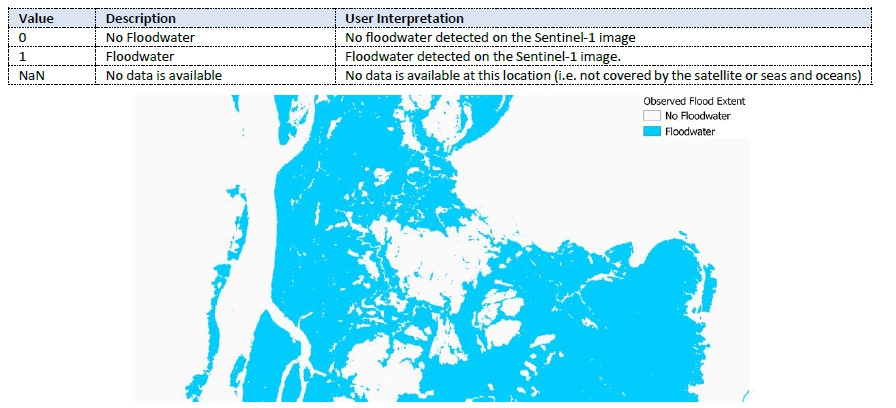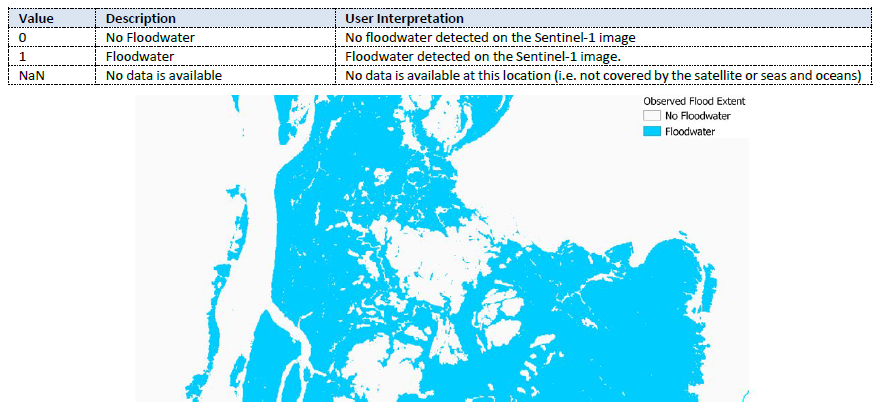Difference between revisions of "S-1 Observed Flood Extent"
(Created page with " Home <br> ---- The Sentinel-1 Observed Flood Extent identifies the pixels covered by floodwater (Figure 27). Pixels being usually under water (identified based on...") |
|||
| (14 intermediate revisions by the same user not shown) | |||
| Line 1: | Line 1: | ||
| − | [[GFMS | Home]] | + | [[File:example7.jpg|right|100px|caption]] |
| + | [[GFMS | [Home]]] - [[PRODUCTS | [back to GFM Products]]] | ||
---- | ---- | ||
| − | The Sentinel-1 Observed Flood Extent identifies the pixels covered by floodwater | + | The '''Sentinel-1 Observed Flood Extent''' identifies the pixels covered by floodwater. <br> |
| + | Pixels being usually under water (identified based on the monthly “Sentinel-1 Reference Water Mask” are not part of the Sentinel-1 Observed Flood Extent. This mask is obtained using the ensemble flood mapping algorithm described in section 0. <br> | ||
| + | During the NRT operation, the acquisition month of the Sentinel-1 scene is retrieved from the“Sentinel-1 Metadata” and the corresponding monthly “Sentinel-1 Reference Water Mask” is cropped to the extent of the processed Sentinel-1 scene. The Sentinel-1 Observed Flood Extent values are described below. | ||
| + | |||
| + | [[File:figure1.jpg|border|centre]] | ||
| + | [[File:figure1_bis.jpg|border|centre]] | ||
| + | [[File:figure1_ter.png|border|centre]] | ||
| + | |||
| + | |||
| + | ====<u>Ensemble algorithm</u>==== | ||
| + | The three algorithms (namely, '''[[HASARD]]''', '''[[ALGORITHM2]]''' , and '''[[ALGORITHM3]]''' will run in parallel and have access to the same pre-processed Sentinel-1 input data. <br> | ||
| + | Next, the three generated flood and water extent maps are systematically combined into a single product (i.e. '''consensus map'''). To generate the combined product, each pixel is attributed the ratio of the number of classifications as flooded to the number of algorithms that were applied:<br> | ||
| + | <u>a number of 1 would mean that all three algorithms agreed on its classification as flooded</u>.<br> | ||
| + | |||
| + | The final classification is straightforward and based on a majority decision, i.e. <u>a pixel is accepted as flooded when at least two algorithms classify it as water</u>. As a result, all other pixels of the Sentinel-1 footprint and not included in a pre-computed exclusion mask are classified as unflooded. <br> | ||
| + | |||
| + | In the unlikely scenario that one or two algorithms fail to produce a result, the results of a single algorithm will be used to compute the final map. In case of a split decision between two algorithms, preference will be given to the algorithm that produced the highest [https://en.wikipedia.org/wiki/Forecast_skill CSI score] during the quality assurance procedure. | ||
| + | |||
| + | '''The ensemble algorithm integrates the results of three leading edge classification algorithms into a single product'''. It '''combines in a single approach the most advanced processing steps''' currently used in the field of SAR-based flood and water extent mapping (i.e. parameter optimization based on time series analysis at local and regional scale, region growing, combination of SAR intensity and ancillary data such as topography, etc.). The consensus product substantially '''improves the robustness and accuracy''' of the final product, in addition to building a '''high degree of redundancy''' into the production service. | ||
| + | |||
| + | |||
| + | ---- | ||
| + | [[GFMS | [Home]]] - [[PRODUCTS | [back to GFM Products]]] | ||
Latest revision as of 07:44, 30 July 2021
[Home] - [back to GFM Products]
The Sentinel-1 Observed Flood Extent identifies the pixels covered by floodwater.
Pixels being usually under water (identified based on the monthly “Sentinel-1 Reference Water Mask” are not part of the Sentinel-1 Observed Flood Extent. This mask is obtained using the ensemble flood mapping algorithm described in section 0.
During the NRT operation, the acquisition month of the Sentinel-1 scene is retrieved from the“Sentinel-1 Metadata” and the corresponding monthly “Sentinel-1 Reference Water Mask” is cropped to the extent of the processed Sentinel-1 scene. The Sentinel-1 Observed Flood Extent values are described below.
Ensemble algorithm
The three algorithms (namely, HASARD, ALGORITHM2 , and ALGORITHM3 will run in parallel and have access to the same pre-processed Sentinel-1 input data.
Next, the three generated flood and water extent maps are systematically combined into a single product (i.e. consensus map). To generate the combined product, each pixel is attributed the ratio of the number of classifications as flooded to the number of algorithms that were applied:
a number of 1 would mean that all three algorithms agreed on its classification as flooded.
The final classification is straightforward and based on a majority decision, i.e. a pixel is accepted as flooded when at least two algorithms classify it as water. As a result, all other pixels of the Sentinel-1 footprint and not included in a pre-computed exclusion mask are classified as unflooded.
In the unlikely scenario that one or two algorithms fail to produce a result, the results of a single algorithm will be used to compute the final map. In case of a split decision between two algorithms, preference will be given to the algorithm that produced the highest CSI score during the quality assurance procedure.
The ensemble algorithm integrates the results of three leading edge classification algorithms into a single product. It combines in a single approach the most advanced processing steps currently used in the field of SAR-based flood and water extent mapping (i.e. parameter optimization based on time series analysis at local and regional scale, region growing, combination of SAR intensity and ancillary data such as topography, etc.). The consensus product substantially improves the robustness and accuracy of the final product, in addition to building a high degree of redundancy into the production service.



